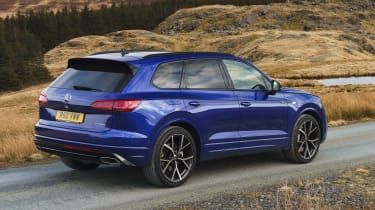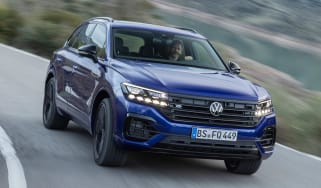Volkswagen Touareg R review
The Volkswagen Touareg R adds plug-in power to the sporty SUV formula, yet it lacks the refinement and engagement of its rivals
Pros
- Lots of technology inside
- Good standard equipment
- Cheaper to run than petrol or diesel
Cons
- Refinement not the best
- Large wheels hurt ride comfort
- Weight affects handling and agility
| Car type | Electric range | Fuel economy | CO2 emissions |
|---|---|---|---|
| Plug-in hybrid | 28 miles | 94mpg | 67g/km |
The Volkswagen Touareg R is the biggest and baddest model in Volkswagen’s range – and it's a plug-in hybrid. Sure, it isn’t pure-electric like the upcoming GTX range of high-performance electric Volkswagens, but electrification should improve the Touareg’s efficiency without compromising driver enjoyment – in theory.
Coming in at just under £72,000, the Touareg R uses a 3.0-litre turbocharged V6 petrol engine combined with a 134bhp electric motor for a total of 456bhp and 700Nm of torque. The sprint from 0-62mph is dealt with in 5.1 seconds, which is impressive given the R’s size and weight. The Touareg R also uses VW's '4MOTION' four-wheel-drive system, which can send up to 80% of its drive to the rear axle.
Thanks to its hybrid powertrain, the R can achieve up to 94.2mpg fuel economy and CO2 emissions of 67g/km, which means the R qualifies for a Benefit-in-Kind company-car tax rating of 17%. The 14.3kWh battery also means the Touareg R has a maximum electric range of 28 miles.
However, the added weight of the hybrid powertrain is very noticeable in the Touareg R. Although it results in some impressive straight-line speed, it also dulls the responsiveness of the car. Despite cornering with little body roll, it never feels dynamic and the chassis sometimes struggles to keep up with your demands. Plus, the added weight of the batteries is perhaps asking too much of the suspension setup.
The Touareg R is at its best when the electric motor’s torque is used to supplement the smooth V6 engine. When cruising, the inaudible electric assistance provides a refinement previously impossible without a hybrid powertrain. It means the R feels more relaxed than the badge on the bootlid might suggest.
The Volkswagen is best suited to driving at a more leisurely pace, then, which is firmly at odds with the R badge this car sports. It lacks the sporting characteristics you'd normally associate with the R name, and the more comfortable ride quality we’ve experienced in this car's rivals, like the BMW X5 xDrive45e.
Plus, despite the capabilities of the 4MOTION system, it never feels like a rear-biased car on the road, nor do you feel the benefit of a system that can adjust itself in such a way. The BMW also offers a longer, more usable electric driving range thanks to its larger battery. Attempting to make the car either feel or appear sportier, Volkswagen has also fitted the R with 22-inch alloy wheels. Although it comes with air suspension, those larger wheels do compromise the ride quality due to how they respond to potholes – or any kind of bump.
Inside, however, the Touareg R still features the latest Volkswagen amenities. The huge 15-inch central touchscreen works well, as does the 12.3-inch digital driver’s display. The Touareg R comes with lots of additional technology, like sat nav, Apple CarPlay, Android Auto, heated and ventilated leather sports seats, keyless operation, a panoramic roof, a 360-degree camera, front and rear parking sensors, four-zone climate control, a powered tailgate and plenty of safety features. Overall quality and standard equipment is high, if a little lacking in the flourishes you'd expect at this price point.
While this car will be cheaper to run than a purely petrol or diesel SUV, the hybrid powertrain in the end is more of a hindrance to the Touareg R reaching the potential of its name badge. It's neither an efficient, well refined plug-in hybrid, nor an engaging, high-performance SUV. It fails to do either task as well as it could, whereas the BMW X5 xDrive45e offers you both for the same price.






